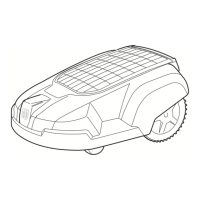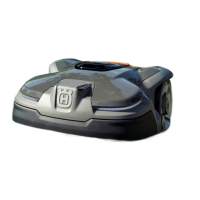Symptoms Cause Action
Both the mowing
and charging times
are shorter than
usual.
The battery is spent. Replace the battery. Refer to
To re-
move the battery on page 45
.
The product is
parked for hours in
the charging sta-
tion.
The product has an inbuilt standby peri-
od according to the Standby time table.
Refer to
Timer and Standby on page
29
.
No action.
The STOP button has been activated. Open the hatch, enter the PIN code
and confirm with the OK button. Press
the Start button and then close the
hatch.
Uneven mowing
results.
The product works too few hours per
day.
Increase the mowing time. Refer to
To
calculate the timer setting on page 23
.
The shape of the work area requires
the use of the
Remote start
function for
the product to find its way to all remote
areas.
Steer the product to a remote area. Re-
fer to
Remote start 2 on page 24
.
The
Proportion
setting is incorrect in re-
lation to the layout of the work area.
Check that the correct
Proportion
value
is selected.
Work area too large. Try limiting the work area or extending
the work time. Refer to
To do the timer
settings on page 23
.
Dull blades. Replace all the blades. Refer to
Re-
place the blades on page 32
.
Long grass in relation to the set cutting
height.
Increase the cutting height and then
successively lower it.
Accumulation of grass by the blade
disc or around the motor shaft.
Check that the blade disc rotates freely
and easily. If not, screw off the blade
disc and remove grass and foreign ob-
jects. Refer to
Chassis and blade disc
on page 31
.
6.6 Find breaks in the loop wire
Breaks in the loop wire are usually the result of
unintentional physical damage to the wire such
as when gardening with a shovel. In countries
with ground frost, also sharp stones that move in
the ground can damage the wire. Breaks can
also occur due to the wire being stretched
excessively during installation.
Mowing the grass too low right after the
installation can damage wire insulation. Damage
to the insulation may not cause disruptions until
several weeks or months later. To avoid this,
always select the maximum cutting height the
first weeks after installation and then lower the
height one step at a time every second week until
the desired cutting height has been reached.
A defective splicing of the loop wire can also lead
to disruptions several weeks after the splice was
done. A faulty splice can, for example, be the
result of the coupler not being pressed together
hard enough with a pair of pliers, or that a
coupler of lower quality than the original coupler
has been used. Please first check all known
splices before further troubleshooting is done.
42 - Troubleshooting 1285 - 004 - 16.04.2020

